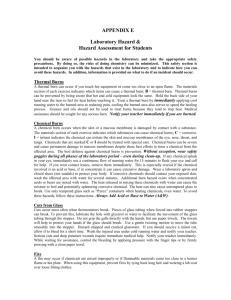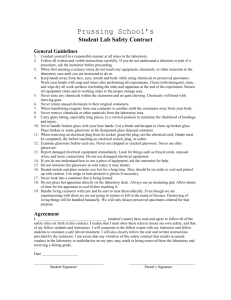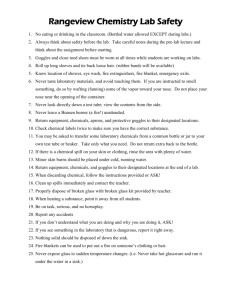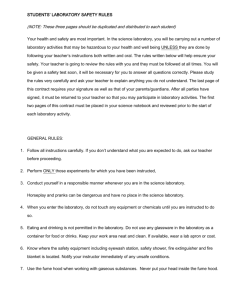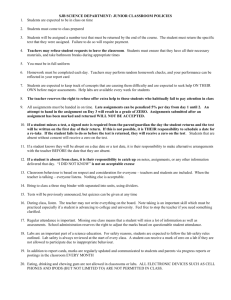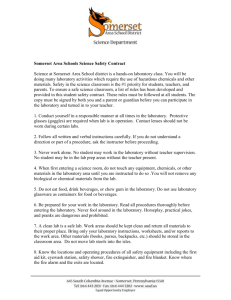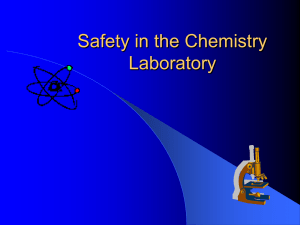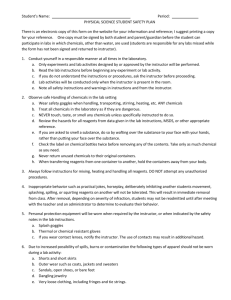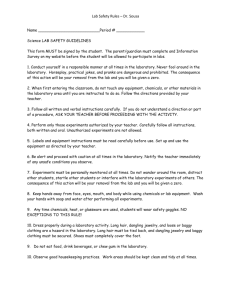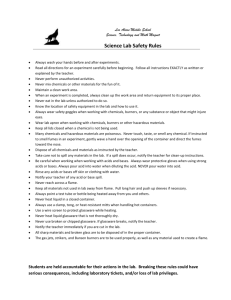laboratory hazards
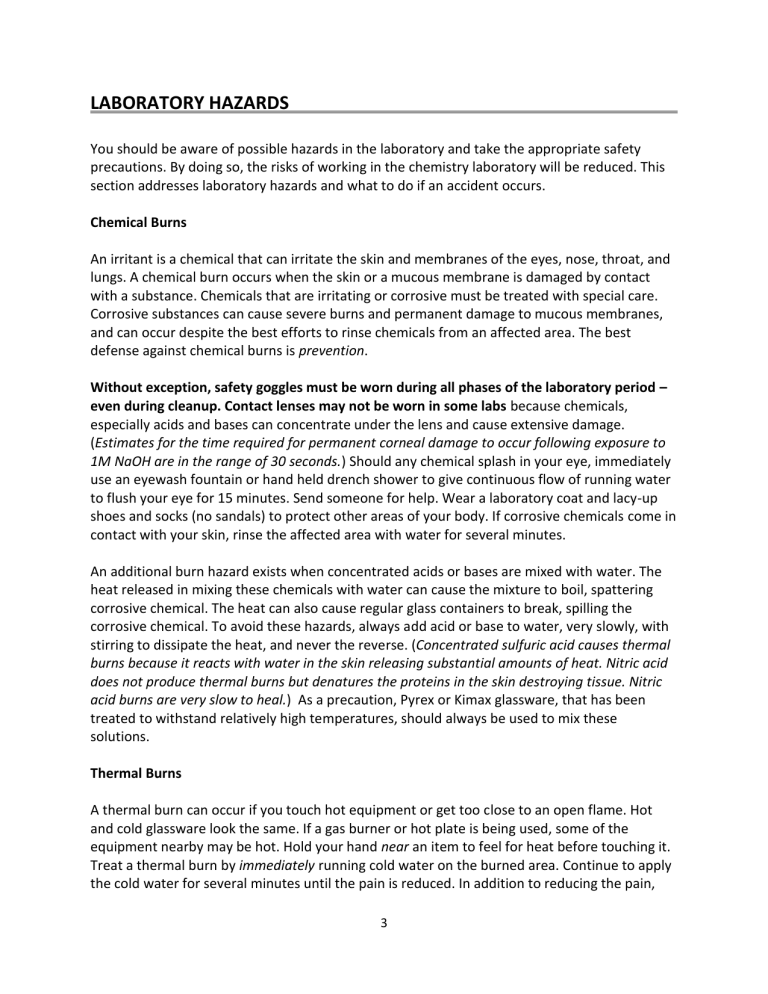
LABORATORY HAZARDS
You should be aware of possible hazards in the laboratory and take the appropriate safety precautions. By doing so, the risks of working in the chemistry laboratory will be reduced. This section addresses laboratory hazards and what to do if an accident occurs.
Chemical Burns
An irritant is a chemical that can irritate the skin and membranes of the eyes, nose, throat, and lungs. A chemical burn occurs when the skin or a mucous membrane is damaged by contact with a substance. Chemicals that are irritating or corrosive must be treated with special care.
Corrosive substances can cause severe burns and permanent damage to mucous membranes, and can occur despite the best efforts to rinse chemicals from an affected area. The best defense against chemical burns is prevention.
Without exception, safety goggles must be worn during all phases of the laboratory period –
even during cleanup. Contact lenses may not be worn in some labs because chemicals, especially acids and bases can concentrate under the lens and cause extensive damage.
(Estimates for the time required for permanent corneal damage to occur following exposure to
1M NaOH are in the range of 30 seconds.) Should any chemical splash in your eye, immediately use an eyewash fountain or hand held drench shower to give continuous flow of running water to flush your eye for 15 minutes. Send someone for help. Wear a laboratory coat and lacy-up shoes and socks (no sandals) to protect other areas of your body. If corrosive chemicals come in contact with your skin, rinse the affected area with water for several minutes.
An additional burn hazard exists when concentrated acids or bases are mixed with water. The heat released in mixing these chemicals with water can cause the mixture to boil, spattering corrosive chemical. The heat can also cause regular glass containers to break, spilling the corrosive chemical. To avoid these hazards, always add acid or base to water, very slowly, with stirring to dissipate the heat, and never the reverse. (Concentrated sulfuric acid causes thermal burns because it reacts with water in the skin releasing substantial amounts of heat. Nitric acid does not produce thermal burns but denatures the proteins in the skin destroying tissue. Nitric
acid burns are very slow to heal.) As a precaution, Pyrex or Kimax glassware, that has been treated to withstand relatively high temperatures, should always be used to mix these solutions.
Thermal Burns
A thermal burn can occur if you touch hot equipment or get too close to an open flame. Hot and cold glassware look the same. If a gas burner or hot plate is being used, some of the equipment nearby may be hot. Hold your hand near an item to feel for heat before touching it.
Treat a thermal burn by immediately running cold water on the burned area. Continue to apply the cold water for several minutes until the pain is reduced. In addition to reducing the pain,
3
cooling the burned area also serves to speed the healing process. Greases and oils should not be used because they ten d to trap heat. Medical assistance should be sought for serious burns.
Notify the teacher immediately if you are burned.
Cuts from Glass
Many cuts that occur in the laboratory can be avoided by following a few simple rules. You should never use broken, cracked, or chipped glassware. If you break a piece of glassware, notify your teacher, but do not pick up the broken glass with your hands. Use a brush or broom and dustpan to sweep up the shards of glass. All broken glass should be placed in the box labeled for broken glass, never in a regular trashcan. If you receive a minor cut, allow the cut to bleed for a short time. Place the injured area under cold running water, and notify your teacher. Serious cuts and deep puncture wounds require immediate medical attention. Quickly notify your teacher. Control the bleeding by applying pressure with the fingertips or by firmly pressing with a clean towel or gauze.
Cuts frequently occur when thermometers or pieces of glass tubing are inserted into rubber stoppers. Prevent cuts by using the correct technique for this procedure. The glass should be lubricated with glycerol or water to facilitate it movement through the stopper. (Glycerol should not be used in the presence of powerful oxidizers such as sulfuric and nitric acids, dichromates or
permanganates.) The glass should be wrapped in paper towels to protect your hands if the glass should break. Use a gentle twisting motion to move the tube smoothly into the stopper.
Poisoning
Many of the chemicals used in the experiments in this manual are mildly to moderately toxic.
To prevent poisoning, never eat, chew gum or drink in the laboratory. Do not touch or taste chemicals. Keep your hands away from your face. In this way you will prevent chemicals that might get on your hands from reaching your mouth, nose or eyes. Always wash your hands with soap and water at the end of the lab.
In some cases, the detection of an odor is used to indicate that a chemical reaction has taken place. It is important to note that many gases are toxic when inhaled. If you must detect an odor, use your hand to gently fan some of the gas toward your nose. Instead of taking a deep breath, gently sniff the gas. This will minimize the amount of gas sampled.
Fire
A fire may occur if chemicals are mixed improperly or if flammable materials come too close to a burner flame or hot plate. When using a hot plate or burner, prevent fires by tying back long hair and securing loose fitting clothing. Use a hot plate as a heat source instead of a burner when flammable chemicals are being used or produced.
4
If hair or clothing should catch fire, do no run; running fans a fire. Stop, drop to the floor and roll slowly to smother the flames. Shout for help. If another person is on fire, get a fire blanket, located at the front of the lab, to smother the flames. If a shower is nearby help the victim use it.
A fire in a container may be put out by covering the container with a fire blanket, lab notebook, or some other nonflammable object. If a fire is on a laboratory workbench, turn off all gas jets and unplug all appliances. Notify the teacher immediately. If a fire extinguisher is needed, the teacher will call for it. To use a fire extinguisher, pull the ring, point the nozzle at the base of the fire, and squeeze the handle. Use short bursts from the extinguisher, rather than one continuous spray. Caution: never direct the spray of a fire extinguisher into a person’s face. If a fire is not extinguished quickly, leave the laboratory. Crawl to the door if necessary to avoid the smoke. Do not return to the laboratory until you are told it is safe.
The signal for a fire drill or fire is the high-pitched beeping of the fire alarm. If the signal is given while in the laboratory, students should exit through the door at the front of the lab and go outside through the double doors to the right. Move away from the building.
Tornado
An announcement over the intercom will be the signal for a tornado drill or warning. If you are in the laboratory when this signal is given, you should return to your classroom if the classroom is H-1 or H-2. If your classroom is H-3, you will leave the lab and go into room H-2. You should sit on the floor facing the wall and protect your head. You should remain in this position until the announcement ending the drill or warning is made.
Always/Never Rules
Always
1.
Always wear safety goggles.
2.
Always wear protective clothing.
3.
Always use proper techniques and procedures.
4.
Always discard wastes properly.
5.
Always know the location and use of safety equipment.
6.
Always be alert, serious and responsible in lab.
Never
1.
Never eat or drink in the lab.
2.
Never clutter your work area.
3.
Never perform unauthorized experiments.
4.
Never enter the chemical storage area.
5.
Never remove stock chemicals from the supply area.
6.
Never take unnecessary risks.
5
